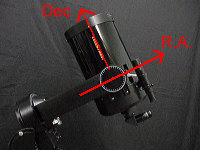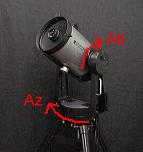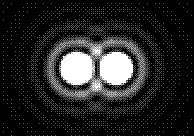Telescope Mountings
There are two main kinds of mountings: one aligned to the stars, called
equatorial, and one aligned with the local horizon, called
alt-azimuth (short for altitude - azimuth).

An equatorial mount has a Right Ascension (R.A.) axis, which is aimed toward Polaris, the north star. The Dec axis is set to find the object. Once aligned the telescope can track the sky using a motor drive to turn the RA axis and allow motion from east to west. |
 Altitude: height above the horizon. Azimuth: angle along the horizon from north. Alt-Az mounts keep the eyepiece in a convenient position at all times. However, they cannot automatically track unless the telescope is computer-controlled. |
 Why use a Telescope?
Why use a Telescope?
Astronomers use telescopes to help them see things that
are dim and small, and they want to see these things clearly!
Light gathering power. Note how the light entering the end of a telescope is 'squished' to exit through a much smaller lens. A bigger objective gathers more light and creates brighter images. Simply put: the larger the objective mirror, the greater the light bucket!
 20-in. Telescope. |
 200-in. Telescope. |
-
Resolving power. Regardless of the amount of light,
a larger objective mirror means we can resolve smaller and
finer details of distant objects. Not only must the object
mirror be large, the optics must be top quality. Our telescopes
are limited, however, by atmospheric seeing:
blurring and distortions in the image brought on by
turbulent regions of air with differing temperatures.
Magnification. While this is usually what's stated in advertisements for telescopes, it's really not very important. Only the eyepiece does the magnifying, and it's easy to buy a new eyepiece (though they can get pricey). If the telescope does not deliver on the afore mentioned characteristics, a high magnification won't be of much use!